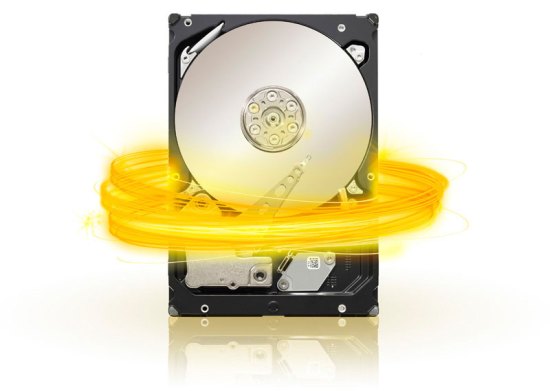“Seagate’s Barracuda XT is the first—and for now the only—mechanical hard drive on the market to support the new SATA 6Gb/s standard.”
- Huge capacity (2TB)
- 64MB cache
- Very fast burst read
- Five-year warranty
- Expensive
- SATA 6Gb/s interface yields negligible performance gains
- Activating SATA 6Gb/s interface on current motherboards prevents dual-GPU operation

Introduction
When computer technology takes a step forward, it is sometimes better to stick with the status quo and let someone else help the industry recoup their R&D investment. When video cards first jumped from the AGP slot to PCI Express, for instance: PCI Express videocards didn’t deliver enough of a performance boost to justify buying a whole new motherboard. We could be seeing the same scenario unfold with the next generation of hard drive interface, known as SATA 6Gb/s – but since Seagate’s 2TB Barracuda XT currently is the only hard drive you can buy today that uses the new standard, it’s impossible to know. Theoretically, the SATA 6Gbps delivers twice the throughput of the previous standard, SATA 3Gb/s (as you’ve no doubt guessed, six gigabits per second compared to three gigabits per second); in the real world, it didn’t matter much which interface we connected the Barracuda XT to.
 Features and Design
Features and Design
In fairness, Seagate’s newest drive does deliver twice the capacity and double the cache of its previous top-of-the-line model, the 1TB Barracuda 7200.12, and it’s much faster than that model even when connected to the older SATA 3Gb/s interface (the drive is backward compatible). So you can buy one of these drives and connect it to the SATA 3Gb/s interface on your existing motherboard and get both huge capacity and excellent performance. We tested the Barracuda XT using one of the few motherboards to feature both a SATA 3Gb/s interface and a SATA 6Gb/s interface, Gigabyte’s new GA-P55A-UD6 (this motherboard has six ports for the former and two for the latter).
The P55A-UD6 uses Intel’s new LGA 1156 CPU socket and P55 chipset, so we paired it with Intel’s 2.8GHz quad-core Core i7 860 CPU and 4GB of Kingston HyperX 2133MHz DDR3 memory. The P55 chipset doesn’t support the SATA 6Gb/s interface directly, so Gigabyte tapped Marvell’s SE9128 interface chip to do the job. (Note: The P55 chipset doesn’t support USB 3.0 either, so Gigabyte added an NEC USB 3.0 controller chip, which supports two of those next-gen connectors.) The P55 chipset does support dual video card solutions (both Nvidia’s SLI and AMD’s CrossFire), but there’s a catch: Socket 1156 Core i7 CPUs have an onboard PCI Express 2.0 controller that can support either one x16 (i.e., 16-lane) PCI Express slot or two x8 (i.e., eight-lane) PCI Express slots. Since Marvell’s SATA 6Gb/s commandeers eight PCI Express lanes for itself, the motherboard and CPU can’t deliver both dual-GPU support and SATA 6Gb/s support at the same time. Drop a second videocard under the hood and the SATA 6Gb/s hard drive interface drops down to SATA 3Gb/s.
 Performance
Performance
We used the hard-drive benchmarking tool h2benchw to measure average sustained transfer rates and random access speeds while reading and writing. We then measured the drive’s burst speed with the benchmark utility HDTach (burst speed measures how fast data can be retrieved from the drive’s cache, versus pulling it off the spinning platters). Connected to the motherboard’s 3Gb/s SATA interface, the Barracuda XT delivered an average sustained transfer rate of 109.1MB/s while reading and 106.4MB/s while writing. When we switched the drive over to the 3Gb/s interface, we saw only the most insignificant drop in throughput: 108.9MB/s while reading and 106.3MB/s while writing.
While that’s hardly worthy of excitement, the drive proved to be considerably faster than Seagate’s 1TB drive, the Barracuda 7200.12, which produced average sustained transfer rates of just 97.8MB/s while reading and 93.0MB/s while writing. The Barracuda XT also delivered a very impressive burst read speed while connected to the 6Gb/s controller: 300.0MB/sec compared to just 225.6MB/sec when running on the 3Gb/s controller.
Conclusion
Seagate’s Barracuda XT is the first—and for now the only—mechanical hard drive on the market to support the new SATA 6Gb/s standard. It’s also the only 2TB drive other than Western Digital’s similarly priced Caviar Black to sport a 64MB cache. Those facts probably justify the Barracuda’s premium price tag compared to the 2TB offerings from Hitachi and Samsung. Only time will tell if the SATA 6Gb/s interface proves to be an important advance for mechanical hard drives (it most likely will be for solid-state drives, which are already saturating the SATA 3Gb/s interface), but nothing we saw in our benchmarks justifies a motherboard swap to accommodate the Barracuda XT today.
Highs:
- Huge capacity (2TB)
- 64MB cache
- Very fast burst read
- Five-year warranty
Lows:
- Expensive
- SATA 6Gb/s interface yields negligible performance gains
- Activating SATA 6Gb/s interface on current motherboards prevents dual-GPU operation




